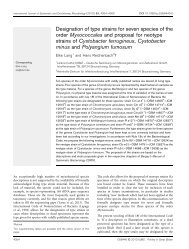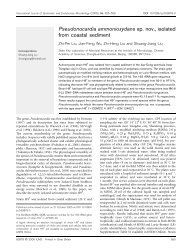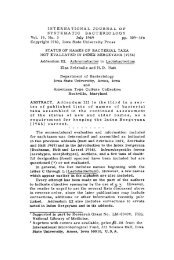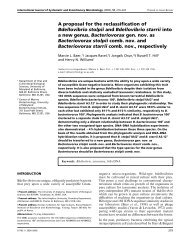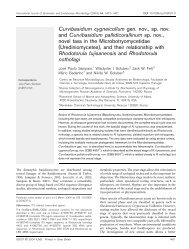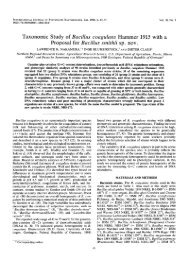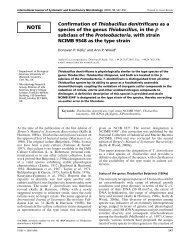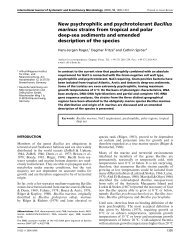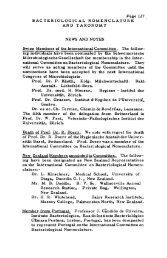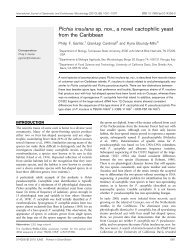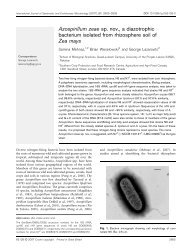Lactobacillus senmaizukei sp. nov., isolated from Japanese pickle
Lactobacillus senmaizukei sp. nov., isolated from Japanese pickle
Lactobacillus senmaizukei sp. nov., isolated from Japanese pickle
You also want an ePaper? Increase the reach of your titles
YUMPU automatically turns print PDFs into web optimized ePapers that Google loves.
International Journal of Systematic and Evolutionary Microbiology (2008), 58, 1625–1629<br />
DOI 10.1099/ijs.0.65677-0<br />
<strong>Lactobacillus</strong> <strong>senmaizukei</strong> <strong>sp</strong>. <strong>nov</strong>., <strong>isolated</strong> <strong>from</strong><br />
<strong>Japanese</strong> <strong>pickle</strong><br />
Kazumi Hiraga, 1 Yoshie Ueno, 2 Sirapan Sukontasing, 3<br />
Somboon Tanasupawat 3 and Kohei Oda 1<br />
Corre<strong>sp</strong>ondence<br />
Kohei Oda<br />
bika@kit.ac.jp<br />
1 Department of Applied Biology, Graduate School of Science and Technology, Kyoto Institute of<br />
Technology, Goshokaido-cho, Matsugasaki, Sakyo-ku, Kyoto 606-8585, Japan<br />
2 Kyoto Prefectural Technology Center for Small and Medium Enterprise, 134 Chudoji,<br />
Minamimachi, Shimogyo-ku, Kyoto 600-8813, Japan<br />
3 Department of Microbiology, Faculty of Pharmaceutical Sciences, Chulalongkorn University,<br />
Bangkok 10330, Thailand<br />
The taxonomic position of a lactic acid bacterium, strain L13 T , <strong>isolated</strong> <strong>from</strong> senmaizuke, a<br />
<strong>Japanese</strong> traditional <strong>pickle</strong>, was studied. This strain was a heterofermentative, facultatively<br />
anaerobic, Gram-positive, non-<strong>sp</strong>ore-forming, non-motile, rod-shaped bacterium. It produced DLlactic<br />
acid <strong>from</strong> glucose. Phylogenetic analysis of its 16S rRNA gene sequence and physiological<br />
and biochemical characteristics indicated that the strain was a member of the genus<br />
<strong>Lactobacillus</strong>. Based on 16S rRNA gene sequence similarity, strain L13 T was closely related to<br />
<strong>Lactobacillus</strong> hammesii CIP 108387 T (98.9 %) and <strong>Lactobacillus</strong> parabrevis ATCC 53295 T<br />
(98.5 %). In addition, the rpoA gene sequence of strain L13 T was closely related to those of L.<br />
hammesii CIP 108387 T (92.2 %) and L. parabrevis ATCC 53295 T (92.0 %). However, DNA–<br />
DNA hybridization of strain L13 T with these two strains revealed that strain L13 T represents a<br />
separate genomic <strong>sp</strong>ecies. The DNA G+C content of strain L13 T was 46 mol% and the<br />
peptidoglycan was of the A4a L-Lys–D-A<strong>sp</strong> type. Thus, these data indicate that strain L13 T<br />
represents a <strong>nov</strong>el <strong>sp</strong>ecies of the genus <strong>Lactobacillus</strong>, for which the name <strong>Lactobacillus</strong><br />
<strong>senmaizukei</strong> is proposed. The type strain is L13 T (5NBRC 103853 T 5TISTR 1847 T ).<br />
Japan, like many other countries, has a long tradition of<br />
producing <strong>pickle</strong>s. Pickles can be used as good screening<br />
sources for the isolation of valuable micro-organisms, e.g.<br />
lactic acid bacteria. Recently, a bacterium, strain L13 T , was<br />
<strong>isolated</strong> <strong>from</strong> senmaizuke, one of the traditional fermented<br />
<strong>pickle</strong>s made <strong>from</strong> <strong>Japanese</strong> radish in Kyoto, Japan (Ueno<br />
et al., 2007). In this study, strain L13 T was assessed using<br />
phenotypic and chemotaxonomic characteristics, 16S<br />
rRNA and RNA polymerase alpha subunit (rpoA) gene<br />
sequence analyses and DNA–DNA relatedness studies. The<br />
results showed that strain L13 T represents a <strong>nov</strong>el <strong>sp</strong>ecies of<br />
the genus <strong>Lactobacillus</strong>.<br />
The GenBank/EMBL/DDBJ accession numbers for the 16S rRNA and<br />
rpoA gene sequences of strain L13 T are AB297927 and AB359074,<br />
re<strong>sp</strong>ectively. The accession number for the rpoA gene sequence of<br />
<strong>Lactobacillus</strong> parabrevis ATCC 53295 T is AB359076.<br />
Phylogenetic trees based on 16S rRNA gene sequences derived by the<br />
neighbour-joining (Supplementary Fig. S1), maximum-likelihood<br />
(Supplementary Fig. S2) and maximum-parsimony (Supplementary Fig.<br />
S3) methods showing the position of <strong>Lactobacillus</strong> <strong>senmaizukei</strong> L13 T<br />
among selected lactobacilli are available with the online version of this<br />
paper.<br />
One hundred colonies were <strong>isolated</strong> <strong>from</strong> senmaizuke after<br />
cultivation on GYP agar plates (Ueno et al., 1997) at 30 uC<br />
for 5 days. Colonies were cultivated anaerobically in GYP<br />
liquid medium containing 5 % sodium glutamate at 30 uC<br />
for 48 h. The culture supernatant of each isolate was<br />
analysed for production of c-aminobutyric acid by TLC<br />
(Ueno et al., 2007); strain L13 T was obtained as a high-level<br />
producer of c-aminobutyric acid. Cell morphology, Gram<br />
staining, colony appearance, <strong>sp</strong>ore formation and catalase<br />
activity were examined on GYP agar after incubation for<br />
48 h. Sugar fermentation patterns were determined using<br />
the API 50 CH and API 50 CHL kits (bioMérieux) over a<br />
period of 72 h cultivation at 30 uC. An F-kit DL-lactic acid<br />
(Roche Diagnostics) was used to determine production of<br />
D- and L-lactic acids <strong>from</strong> glucose. The effects of various<br />
temperatures on growth were determined by using GYP<br />
broth at 15, 30 and 45 uC. Bacterial growth was monitored<br />
by measurement of OD 660 . Tolerance of NaCl was<br />
examined by adding 1, 2, 3, 4, 5, 6, 7, 8, 9 and 10 %<br />
(w/v) NaCl to GYP broth. Production of ammonia <strong>from</strong><br />
arginine was determined according to the method of Abo-<br />
Elnaga & Kandler (1965). The cell wall composition was<br />
determined according to Schleifer & Kandler (1972).<br />
65677 G 2008 IUMS Printed in Great Britain 1625
K. Hiraga and others<br />
DNA was <strong>isolated</strong> by using the lytic enzyme labiase<br />
according to the method of Niwa et al. (2005) with some<br />
modifications. Genomic DNA was extracted <strong>from</strong> 0.36 g<br />
wet weight cells as follows. After addition of 0.36 ml 0.1 M<br />
acetate buffer (pH 4.0) and 0.36 ml 4 mg labiase ml 21 to<br />
the cells, the cell su<strong>sp</strong>ension was incubated for 10 min at<br />
55 uC. After this incubation, 0.39 ml 20 % SDS was added<br />
and the su<strong>sp</strong>ension was mixed gently and incubated for<br />
5 min at 55 uC. After addition of 2 ml 5 mg RNase solution<br />
ml 21 , the su<strong>sp</strong>ension was incubated at 37 uC for 1 h.<br />
Subsequent chloroform/isoamyl alcohol extraction, precipitation<br />
and <strong>sp</strong>ooling of DNA on a glass rod were performed<br />
as described by Marmur (1961). The <strong>isolated</strong> genomic<br />
DNA was used for amplification of the 16S rRNA gene by<br />
PCR using primers 27f (59-AGAGTTTGATCCTGG-<br />
CTCAG-39) and 1492r (59-GGCTACCTTGTTACGACTT-<br />
39) (Weisburg et al., 1991). The rpoA gene was amplified as<br />
described by Naser et al. (2005). The rpoA gene of<br />
<strong>Lactobacillus</strong> parabrevis ATCC 53295 T was also amplified<br />
and analysed since it was not available in the database.<br />
Phylogenetic trees were constructed by the neighbourjoining<br />
method (Saitou & Nei, 1987) using the NJPLOT<br />
program (Perrière & Gouy, 1996) and by the maximumlikelihood<br />
(Felsenstein, 1989) and maximum-parsimony<br />
methods using MEGA version 3.1 (Kumar et al., 2004).<br />
Confidence values of branches of the phylogenetic tree<br />
were determined using bootstrap analysis (Felsenstein,<br />
1985) based on 1000 resamplings. DNA–DNA hybridization<br />
was carried out as described by Ezaki et al. (1989) and<br />
the G+C content of the DNA was determined according to<br />
Mesbah et al. (1989). Metabolites <strong>from</strong> glucose were<br />
analysed by HPLC. A Develosil RPAQUEOUS-AR-5<br />
column (Nomura Chemical) was used for organic acid<br />
detection (detection, 210 nm; mobile phase, acetonitrile;<br />
column oven, 35 uC) and a Develosil C30-UG-5 column<br />
(Nomura Chemical) was used for ethanol detection<br />
(detection, refractive index detector; mobile phase, miliQ<br />
water; column oven, 40 uC).<br />
Strain L13 T was characterized phenotypically and genotypically<br />
(Table 1). It was a heterofermentative, facultatively<br />
anaerobic, Gram-positive, non-<strong>sp</strong>ore-forming, non-motile,<br />
catalase-negative, rod-shaped bacterium. Based on 16S<br />
rRNA gene sequence similarity (Fig. 1), strain L13 T<br />
belonged to the genus <strong>Lactobacillus</strong> and it was closely<br />
related to <strong>Lactobacillus</strong> hammesii CIP 108387 T (98.9 %), L.<br />
parabrevis ATCC 53295 T (98.5 %) and <strong>Lactobacillus</strong> brevis<br />
LMG 6906 T (97.6 %). Additional trees constructed by the<br />
neighbour-joining, maximum-likelihood and maximumparsimony<br />
methods are available as Supplementary Figs S1,<br />
S2 and S3, re<strong>sp</strong>ectively, in IJSEM Online. In addition, the<br />
rpoA gene sequence of strain L13 T showed similarities of<br />
92.2 and 92.0 % to L. hammesii CIP 108387 T and L.<br />
parabrevis ATCC 53295 T , re<strong>sp</strong>ectively, as shown in Fig. 2.<br />
Thus, rpoA gene analysis also showed that strain L13 T was<br />
closely related to these strains. L. parabrevis ATCC 53295 T<br />
was <strong>isolated</strong> <strong>from</strong> wheat and originally deposited with the<br />
ATCC as L. brevis (Spiller, 1987); it has recently been<br />
reclassified as L. parabrevis ATCC 53295 T (Vancanneyt et<br />
al., 2006). DNA–DNA relatedness values of strain L13 T to<br />
L. parabrevis ATCC 53295 T and L. hammesii CIP 108387 T<br />
were 8.3 and 6.3 %, re<strong>sp</strong>ectively. These values are below the<br />
Table 1. Differential characteristics of strain L13 T and closely related <strong>Lactobacillus</strong> <strong>sp</strong>ecies<br />
Strains: 1, L13 T ;2,L. parabrevis ATCC 53295 T (data <strong>from</strong> Vancanneyt et al., 2006); 3, L. hammesii CIP 108387 T<br />
(Valcheva et al., 2005). +, Positive; 2, negative; W, weakly positive; ND, not determined.<br />
Characteristic 1 2 3<br />
NH 3 <strong>from</strong> arginine 2 + 2<br />
Acid production <strong>from</strong>:<br />
Aesculin + 2 +<br />
L-Arabinose 2 + +<br />
D-Arabitol 2 + ND<br />
Cellobiose 2 2 +<br />
D-Fructose W + +<br />
D-Gluconate W + ND<br />
2-Keto-D-gluconate W 2 ND<br />
N-Acetylglucosamine W + +<br />
D-Glucose W + +<br />
Maltose 2 + +<br />
Mannitol 2 2 +<br />
Mannose 2 2 +<br />
D-Ribose + + ND<br />
Trehalose 2 2 +<br />
Methyl b-xyloside 2 + +<br />
DNA G+C content (mol%) 46 49 52.6<br />
1626 International Journal of Systematic and Evolutionary Microbiology 58
<strong>Lactobacillus</strong> <strong>senmaizukei</strong> <strong>sp</strong>. <strong>nov</strong>.<br />
Fig. 1. Phylogenetic tree derived <strong>from</strong> 16S<br />
rRNA gene sequence analysis showing the<br />
position of <strong>Lactobacillus</strong> <strong>senmaizukei</strong> L13 T<br />
among selected lactobacilli. The tree was<br />
generated by the neighbour-joining method.<br />
Bootstrap percentages above 55 %, based on<br />
1000 replications, are given at nodes. Bar,<br />
0.02 substitutions per nucleotide position.<br />
threshold of 70 % suggested for <strong>sp</strong>ecies delineation (Wayne<br />
et al., 1987; Stackebrandt & Goebel, 1994), thus indicating<br />
that strain L13 T represents a separate genomic <strong>sp</strong>ecies. The<br />
DNA G+C content of strain L13 T was 46 mol%, which is<br />
within the range (32–55 mol%) reported for other <strong>sp</strong>ecies<br />
of the genus <strong>Lactobacillus</strong> (Kandler & Weiss, 1986). The cell<br />
wall composition was lysine and a<strong>sp</strong>artic acid, indicating<br />
peptidoglycan type A4a L-Lys–D-A<strong>sp</strong>. Strain L13 T could<br />
not produce acid <strong>from</strong> L-arabinose, methyl b-xyloside or<br />
maltose. It could grow slowly and heterofermentatively in<br />
glucose-containing medium (GYP) at 30 uC and a small<br />
amount of DL-lactate was detected in the medium. Based<br />
on its biochemical properties, sugar fermentation patterns,<br />
DNA G+C content and DNA–DNA hybridization experiments,<br />
strain L13 T clearly differed <strong>from</strong> L. parabrevis ATCC<br />
53295 T (Vancanneyt et al., 2006) and L. hammesii CIP<br />
108387 T (Valcheva et al., 2005). Thus, strain L13 T<br />
represents a <strong>nov</strong>el <strong>sp</strong>ecies of the genus <strong>Lactobacillus</strong>, for<br />
which the name <strong>Lactobacillus</strong> <strong>senmaizukei</strong> is proposed.<br />
Description of <strong>Lactobacillus</strong> <strong>senmaizukei</strong> <strong>sp</strong>. <strong>nov</strong>.<br />
<strong>Lactobacillus</strong> <strong>senmaizukei</strong> (sen.mai.zu9ke.i. N.L. n. senmaizukeum<br />
senmaizuke, a traditional fermented <strong>pickle</strong>; N.L.<br />
gen. n. <strong>senmaizukei</strong> of senmaizuke, referring to the<br />
isolation of the type strain <strong>from</strong> a traditional fermented<br />
<strong>pickle</strong> produced in Kyoto, Japan).<br />
Cells are Gram-positive, catalase-negative, non-motile,<br />
non-<strong>sp</strong>ore-forming rods (0.5–0.861.0–5.0 mm). Colonies<br />
on GYP agar are circular, low-convex with entire margins<br />
and non-pigmented (1.0–2.0 mm in diameter after 2 days<br />
of growth). Can grow in up to 8.0 % NaCl and at 15 uC,<br />
but not at 45 uC. The <strong>sp</strong>ecific growth rate in 5.0 % NaCl is<br />
50 % (100 % growth without NaCl). Facultatively anaerobic.<br />
Produces DL-lactic acid heterofermentatively <strong>from</strong><br />
glucose. Acetic acid and ethanol are also produced as other<br />
metabolites (HPLC analysis). Acid is produced <strong>from</strong><br />
aesculin, D-fructose, D-galactose, D-gluconate, 2-keto-Dgluconate,<br />
N-acetylglucosamine, D-ribose and D-xylose, but<br />
http://ijs.sgmjournals.org 1627
K. Hiraga and others<br />
Fig. 2. Phylogenetic tree based on rpoA gene<br />
sequences showing the relationship between<br />
<strong>Lactobacillus</strong> <strong>senmaizukei</strong> L13 T and selected<br />
lactobacilli. The branching pattern was generated<br />
by the neighbour-joining method.<br />
Bootstrap percentages above 55 %, based<br />
on 1000 replications, are shown at nodes. Bar,<br />
0.05 substitutions per nucleotide positions.<br />
not <strong>from</strong> adonitol, D-amygdalin, arabinose, arabitol,<br />
arbutin, dulcitol, erythritol, cellobiose, gentiobiose,<br />
5-keto-D-gluconate, methyl a-D-glucoside, glycogen, glycerol,<br />
inositol, inulin, lactose, D-lyxose, maltose, D-<br />
mannitol, D-mannose, methyl a-D-mannoside, melezitose,<br />
melibiose, raffinose, L-rhamnose, salicin, sorbitol, L-sorbose,<br />
starch, sucrose, D-tagatose, trehalose, turanose, xylitol,<br />
L-xylose or methyl b-xyloside. Ammonia is not produced<br />
<strong>from</strong> arginine. Peptidoglycan structure is of the A4a L-Lys–<br />
D-A<strong>sp</strong> type.<br />
The type strain, L13 T (5NBRC 103853 T 5TISTR 1847 T ),<br />
was <strong>isolated</strong> <strong>from</strong> senmaizuke, one of the traditional<br />
<strong>pickle</strong>s <strong>from</strong> Kyoto, Japan. The DNA G+C content of the<br />
type strain is 46 mol%.<br />
References<br />
Abo-Elnaga, I. G. & Kandler, O. (1965). Zur Taxonomie der Gattung<br />
<strong>Lactobacillus</strong> Beijerinck. I. Das Subgenus Streptobacterium Orla-Jensen.<br />
Zentralbl Bakteriol Parasitenkd Infektionskr Hyg 119, 1–36 (in German).<br />
Ezaki, T., Hashimoto, Y. & Yabuuchi, E. (1989). Fluorometric<br />
deoxyribonucleic acid-deoxyribonucleic acid hybridization in microdilution<br />
wells as an alternative to membrane filter hybridization in<br />
which radioisotopes are used to determine genetic relatedness among<br />
bacterial strains. Int J Syst Bacteriol 39, 224–229.<br />
Felsenstein, J. (1985). Confidence limits on phylogenies: an approach<br />
using the bootstrap. Evolution 39, 783–791.<br />
Felsenstein, J. (1989). PHYLIP – phylogeny inference package (version<br />
3.2). Cladistics 5, 164–166.<br />
Kandler, O. & Weiss, N. (1986). Genus <strong>Lactobacillus</strong> Beijerinck 1901,<br />
212 AL .InBergey’s Manual of Systematic Bacteriology, vol. 2, pp. 1209–<br />
1234. Edited by P. H. A. Sneath, N. S. Mair, M. E. Sharpe & J. G. Holt.<br />
Baltimore: Williams & Wilkins.<br />
Kumar, S., Tamura, K. & Nei, M. (2004). MEGA3: Integrated software<br />
for molecular evolutionary genetics analysis and sequence alignment.<br />
Brief Bioinform 5, 150–163.<br />
Marmur, J. (1961). A procedure for the isolation of deoxyribonucleic<br />
acid <strong>from</strong> microorganisms. J Mol Biol 3, 208–218.<br />
Mesbah, M., Premachandran, U. & Whitman, W. B. (1989). Precise<br />
measurement of the G+C content of deoxyribonucleic acid by highperformance<br />
liquid chromatography. Int J Syst Bacteriol 39, 159–167.<br />
Naser, S. M., Thompson, F. L., Hoste, B., Gevers, D., Dawyndt, P.,<br />
Vancanneyt, M. & Swings, J. (2005). Application of multilocus<br />
sequence analysis (MLSA) for rapid identification of Enterococcus<br />
<strong>sp</strong>ecies based on rpoA and pheS genes. Microbiology 151, 2141–2150.<br />
Niwa, T., Kawamura, Y., Katagiri, Y. & Ezaki, T. (2005). Lytic enzyme,<br />
labiase for a broad range of Gram-positive bacteria and its application<br />
to analyze functional DNA/RNA. J Microbiol Methods 61, 251–260.<br />
Perrière, G. & Gouy, M. (1996). WWW-query: an on-line retrieval<br />
system for biological sequence banks. Biochimie 78, 364–369.<br />
Saitou, N. & Nei, M. (1987). The neighbor-joining method: a new<br />
method for reconstructing phylogenetic trees. Mol Biol Evol 4,<br />
406–425.<br />
Schleifer, K. H. & Kandler, O. (1972). Peptidoglycan types of bacterial<br />
cell walls and their taxonomic implications. Bacteriol Rev 36, 407–477.<br />
1628 International Journal of Systematic and Evolutionary Microbiology 58
<strong>Lactobacillus</strong> <strong>senmaizukei</strong> <strong>sp</strong>. <strong>nov</strong>.<br />
Spiller, M. A. (1987). Admixture of a <strong>Lactobacillus</strong> brevis and a<br />
Saccharomyces dairensis for preparing leavening barm. US Patent<br />
4,666,719. 19 May 1987, US Patent Office.<br />
Stackebrandt, E. & Goebel, B. M. (1994). Taxonomic note: a place for<br />
DNA-DNA reassociation and 16S rRNA sequence analysis in the present<br />
<strong>sp</strong>ecies definition in bacteriology. Int J Syst Bacteriol 44, 846–849.<br />
Ueno, Y., Hayakawa, K., Takahashi, S. & Oda, K. (1997). Purification<br />
and characterization of glutamate decarboxylase <strong>from</strong> <strong>Lactobacillus</strong><br />
brevis IFO 12005. Biosci Biotechnol Biochem 61, 1168–1171.<br />
Ueno, Y., Hiraga, K., Mori, Y. & Oda, K. (2007). Isolation and<br />
utilization of a lactic acid bacterium, producing a high level of c-<br />
aminobutyric acid (GABA). Seibutsu-kogaku Kaishi 85, 109–114 (in<br />
<strong>Japanese</strong>).<br />
Valcheva, R., Korakli, M., Onno, B., Prévost, H., Iva<strong>nov</strong>a, I., Ehrmann,<br />
M. A., Dousset, X., Gänzle, M. G. & Vogel, R. F. (2005). <strong>Lactobacillus</strong><br />
hammesii <strong>sp</strong>. <strong>nov</strong>., <strong>isolated</strong> <strong>from</strong> French sourdough. Int J Syst Evol<br />
Microbiol 55, 763–767.<br />
Vancanneyt, M., Naser, S. M., Engelbeen, K., De Wachter, M., Van<br />
der Meulen, R., Cleenwerk, I., Hoste, B., De Vuyst, L. & Swings, J.<br />
(2006). Reclassification of <strong>Lactobacillus</strong> brevis strains LMG 11494 and<br />
LMG 11984 as <strong>Lactobacillus</strong> parabrevis <strong>sp</strong>. <strong>nov</strong>. Int J Syst Evol<br />
Microbiol 56, 1553–1557.<br />
Wayne, L. G., Brenner, D. J., Colwell, R. R., Grimont, P. A. D., Kandler, O.,<br />
Krichevsky, M. I., Moore, L. H., Moore, W. E. C., Murray, R. G. E. & other<br />
authors (1987). International Committee on Systematic Bacteriology.<br />
Report of the ad hoc committee on the reconciliation of approaches to<br />
bacterial systematics. Int J Syst Bacteriol 37, 463–464.<br />
Weisburg, W. G., Barns, S. M., Pelletier, D. A. & Lane, D. J. (1991). 16S<br />
ribosomal DNA amplification for phylogenetic study. J Bacteriol 173,<br />
697–703.<br />
http://ijs.sgmjournals.org 1629



